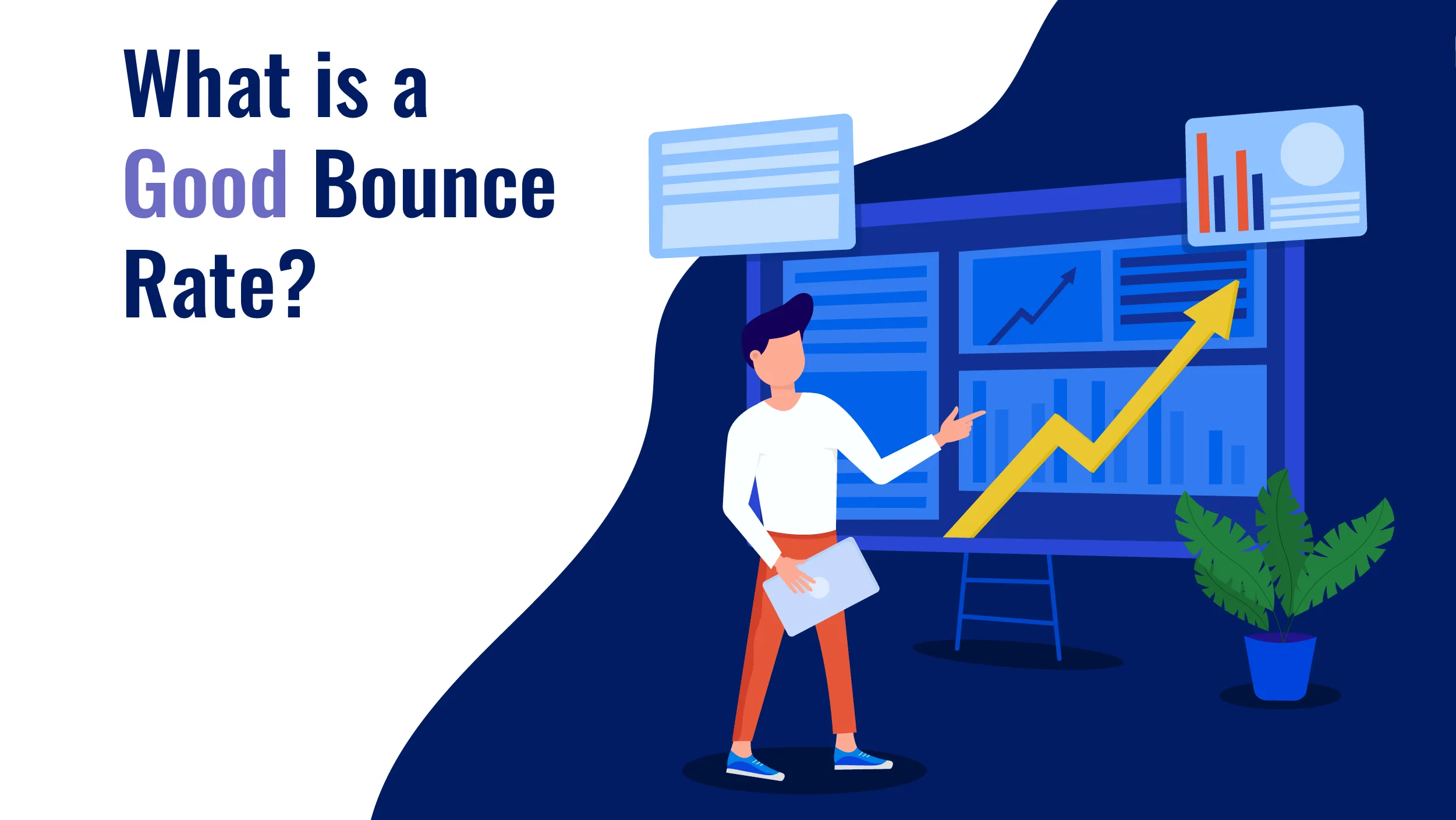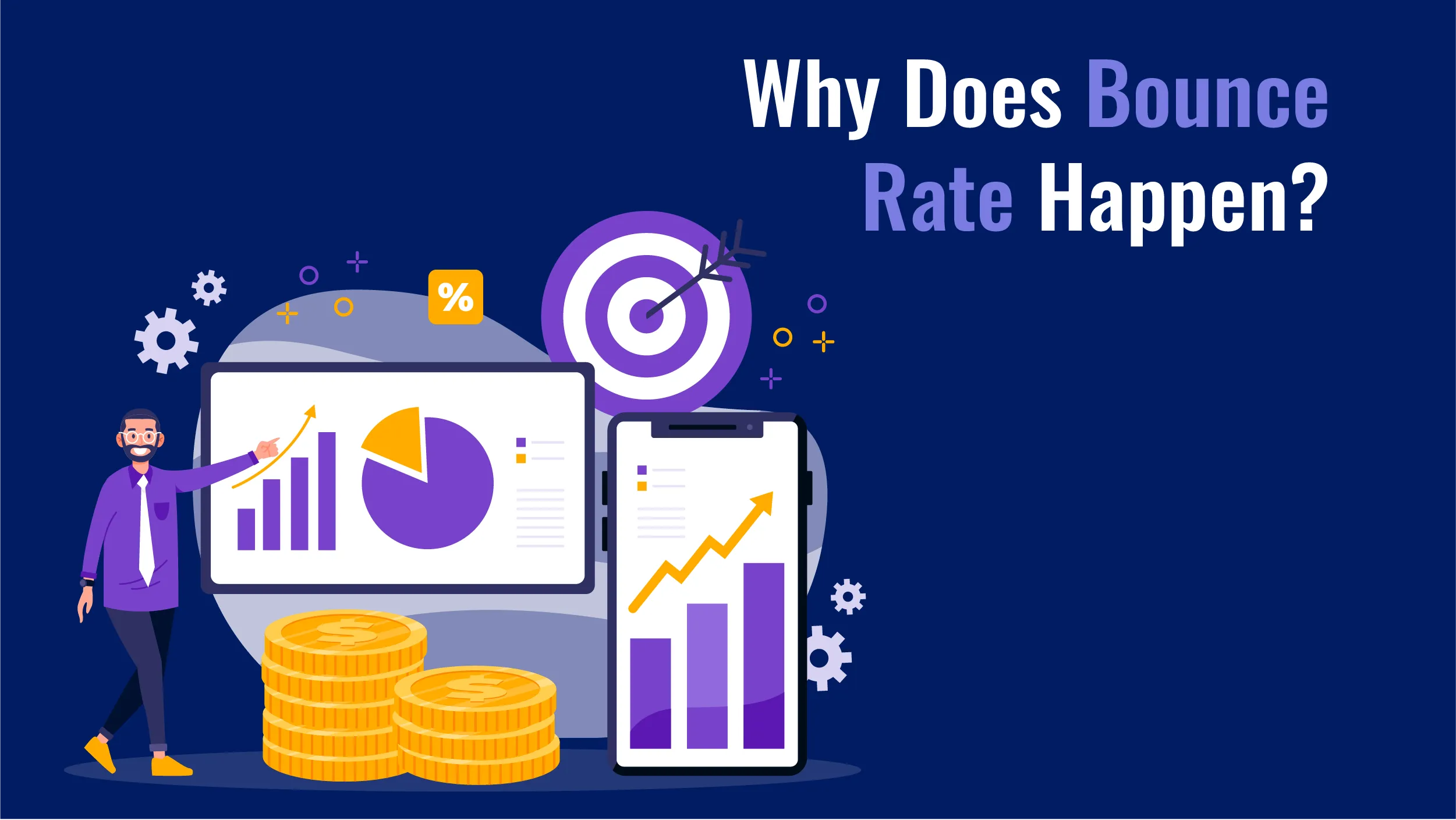Studies reveal that an average human’s attention span is less than 10 seconds. If you run a business or have a product to sell, that 10 seconds is your biggest competitor. People will leave your website if it doesn’t satisfy their intent.
This is exactly what the bounce rate for website is about. Now, there are multiple reasons and ways to tackle this issue. One of the reasons is page load timing. A one-second page load delay increases the likelihood of a bounce by ninety percent. All of the whys and hows are included in this blog post. So read along and anti-bounce your website.
What is Bounce Rate?
The percentage of visitors or users who leave right after landing on a page on your website is called the bounce rate. This means the average percentage of visitors don’t click on anything or take any actions, like filling out a form, enquiring, etc. A GoRocketFuel.com analysis states that the average bounce rate for website ranges from 41 to 51%.There are three key reasons why bounce rate matters, especially to customers:
- Obviously, a person that bounces off your website did not convert. Therefore, your conversion rate takes a bad dip, which will hurt your business.
- One potential Google ranking element is bounce rate. In fact, a study conducted on the sector discovered a strong correlation between bounce rate for website and Google first-page ranks.
- A high bounce rate for a website indicates problems with content, user experience, page layout, or copywriting on your website or particular pages within it.
Also Read: What Is Kiosk Advertising and What are its Benefits?
How to Reduce Your Bounce Rate In 4 Simple Steps?
Ensure Your Website Is Mobile-Friendly
Mobile users account for about half of global web traffic. It’s crucial to provide an engaging mobile-ready experience. Simply having a responsive site isn’t enough; it must be user-friendly and interactive. Videos are particularly engaging, especially AR but can slow down the mobile experience if too long. Vocell suggests using concise videos to maintain engagement without affecting load times. Take a holistic approach to evaluate and improve the mobile experience across all content types.
Look at Your Bounce Rate Based on Different Sources
Analyze your bounce rate by traffic source using tools like the HubSpot Web Analytics Dashboard. If direct traffic has a high bounce rate, check the URL for readability and ensure visitors aren’t landing on 404 errors or an uninviting home page. Clear headlines that signal visitors they are in the right place can help meet their expectations and reduce bounce rates.
Avoid Disruptions That Hurt User Experience
A good user experience is essential across all platforms. Full-screen pop-ups can be annoying and result in search penalties. Vocell emphasizes drawing visitors into your page and keeping them engaged. While some pop-ups are beneficial, avoid those that significantly disrupt the user experience and cause visitors to leave.
Determine Which Keywords Your Page Ranks For
Ensure your content matches the intent of the keywords it ranks for. If someone searches for “marketing automation software solutions,” they likely seek software to nurture leads. In contrast, a search for “What is marketing automation?” indicates a need for informative content rather than a product. Align keywords with your content to meet visitors’ expectations and use a topic-cluster framework to attract organic traffic to the right pages
What is a Good Bounce Rate?

The concept of a “good” bounce rate can vary depending on factors such as the type of website, industry, and target audience.
- A bounce rate of around 40% or lower is generally considered good, while a bounce rate of 50% or higher may indicate the need to evaluate and improve the page’s content and engagement.
- Different types of websites and industries may have different average bounce rates. For example, blogs may have higher bounce rates (around 70% on average), while eCommerce stores may aim for lower bounce rates (between 40% and 60%).
- It’s important to consider the context of your specific website, industry, and target audience when determining what constitutes a good bounce rate.
- Analyzing bounce rate for websites by industry, device type, and traffic source can help identify strategies to reduce bounce rates and increase user engagement.
How to Calculate Bounce Rate?
The number of sessions that are not engaged is divided by the total number of sessions to determine the bounce rate.
Bounce rate for website = unengaged sessions / total sessions
This implies that the engagement rate is the opposite of the bounce rate.
Consequently, if the engagement rate on your website is 70%, your bounce rate will be 30%.
Why Does Bounce Rate Happen?

Here are some reasons why bounce rates for websites happen:
- Irrelevant or Poorly Targeted Traffic: High bounce rates can occur when the website attracts the wrong audience or fails to meet the expectations of visitors. If the content or offerings do not align with what visitors are looking for, they may leave immediately.
- Poor User Experience: Websites with slow loading times, confusing navigation, or a cluttered layout can contribute to high bounce rates. If visitors find it difficult to navigate or access the information they need, they may leave the site quickly.
- Lack of Engaging Content: If the content on a webpage is uninteresting, lacks relevance, or fails to capture the attention of visitors, they may leave without further engagement. Engaging and valuable content can help keep visitors on the page and encourage them to explore more.
- Technical Issues: Technical issues such as broken links, error messages, or non-mobile-friendly designs can lead to high bounce rates. Visitors may become frustrated and leave if they encounter these issues.
- Misleading or Inaccurate Search Results: If visitors arrive at a webpage through search results that do not accurately reflect the content or purpose of the page, they may quickly leave in search of more relevant information.
- Single-Page Interactions: In some cases, a high bounce rate may be expected and not necessarily indicate a problem. For example, if a webpage serves as a landing page with all the necessary information or if visitors are looking for specific information like contact details, they may leave after a single interaction without exploring further.
Final Note on Having a High Rate Of Bounce
Having a high bounce rate for website is detrimental to your business. For instance, you don’t want a high rate of bounces if a large portion of users are viewing your home page and it serves as the entry point to other parts of your website (such as product pages, news articles, and your checkout process).
However, a high percentage of bounces is reasonable if your website is a single-page blog or other content where single-page experiences are expected. Nevertheless, the ultimate goal is to lower bounce and make people stay on your website longer. Follow the steps tackled in this article and retain all bouncing users.




